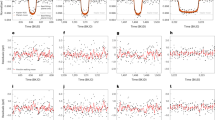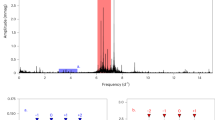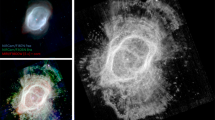Abstract
Preliminary analyses of Vega 1 and Vega 2 images of the comet Halley nucleus have led to a derived rotation period of 53.5±1 hours (2.23±0.04 days) about an axis approximately perpendicular to the long axis of the nucleus,1–3. Images obtained by Giotto4–6 were also found to be consistent with the Vega-derived rotation period. Recently, however, a longer rotation period of 7.4 days has been proposed7, based on an apparent double-peaked periodicity in the production rates of CN, C2 and dust. Although we acknowledge possible photometric evidence for time-variable production rates and appreciate the assumption that this periodicity should somehow be related to the rotation of the nucleus, we conclude, nevertheless, that the imaging observations from the three spacecraft provide a compelling refutation of the proposed 7.4-day rotation period. Of crucial importance to this conclusion are: (1) the non-symmetrical shape of the Halley nucleus; and (2) the independent observations of this irregular body by Vega 1, Vega 2 and Giotto over an interval of 7.7 days. We note, however, that a rotation period of 53.5 hours and a longer period of torque-free precession with the angular momentum vector inclined somewhat to the spin axis might be consistent with both the spacecraft and ground-based observations.
This is a preview of subscription content, access via your institution
Access options
Subscribe to this journal
Receive 51 print issues and online access
$199.00 per year
only $3.90 per issue
Buy this article
- Purchase on Springer Link
- Instant access to full article PDF
Prices may be subject to local taxes which are calculated during checkout
Similar content being viewed by others
References
Sagdeev, R. Z. et al. Nature 321, 262–266 (1986).
Sagdeev, R. Z. et al. COSPAR Proceedings, Toulouse (in the press).
Sagdeev, R. Z. et al. Proc. 20th ESLAB Symp. on the Exploration of Halley's Comet, Vol. II (eds Battrick, B., Rolfe, E. J. & Reinhard, R.) 335–338 (ESA Publications Division, ESTEC, Noordwijk, The Netherlands, 1987).
Keller, H. U. et al. Nature 321, 320–326 (1986).
Keller, H. U. et al. Proc. 20th ESLAB Symp. on the Exploration of Halley's Comet, Vol. II (eds Battrick, B., Rolfe, E. J. & Reinhard, R.) 347–350 (ESA Publications Division, ESTEC, Noordwijk, The Netherlands, 1987).
Reitsema, H. J. Proc. 20th ESLAB Symp. on the Exploration of Halley's Comet, Vol. II (eds Battrick, B, Rolfe, E. J. & Reinhard, R.) 351–354 (ESA Publications Division, ESTEC, Noordwijk, The Netherlands, 1987).
Millis, R. L. & Schleicher, D. G. Nature 324, 646–649 (1986).
Sekanina, Z. Nature 325, 326–328 (1987).
Julian, W. H. Nature 326, 57–58 (1987).
Author information
Authors and Affiliations
Rights and permissions
About this article
Cite this article
Smith, B., Larson, S., Szegö, K. et al. Rejection of a proposed 7.4-day rotation period of the comet Halley nucleus. Nature 326, 573–574 (1987). https://doi.org/10.1038/326573a0
Received:
Accepted:
Issue Date:
DOI: https://doi.org/10.1038/326573a0
This article is cited by
-
Comets
The Astronomy and Astrophysics Review (1993)
-
Indication for precession of comet Halley's nucleus from dust tail analysis
Earth, Moon and Planets (1990)
-
Surface features on the nucleus of comet Halley
Nature (1988)
-
Evidence for the nucleus rotation in streamer patterns of Comet Halley's dust tail
Astrophysics and Space Science (1987)
Comments
By submitting a comment you agree to abide by our Terms and Community Guidelines. If you find something abusive or that does not comply with our terms or guidelines please flag it as inappropriate.



